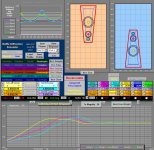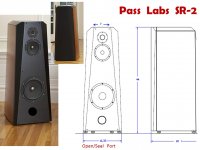I'm designing a 3-way with a baffle that tapers at and 11.25 degree angle from the base to the top. I'm wondering what the baffle step will look like? My best guess at this point would be to use the baffle width at the equator of each driver to calculate the frequency. Any better ideas? I'm sure I will find out eventually by measuring my test box.
The free "Baffle Diffraction Simulator" written by Paul Verdone can give you good starting data (FRD files) which you can input into several crossover simulators
=============
Large radius edge rounds are the other popular option to reduce baffle distortion and create a "style" with a easy to build rectangular cabinet, and a thick baffle. If your router has a 0.5" chuck, a 1.5" radius quarter round bit costs $100-150. If a local cabinet shop has a Shaper with a 3" radius quarter round cutter, you might consider a THICK MDF baffle, or even a JukeBox style round top.
=============
Large radius edge rounds are the other popular option to reduce baffle distortion and create a "style" with a easy to build rectangular cabinet, and a thick baffle. If your router has a 0.5" chuck, a 1.5" radius quarter round bit costs $100-150. If a local cabinet shop has a Shaper with a 3" radius quarter round cutter, you might consider a THICK MDF baffle, or even a JukeBox style round top.
Attachments
The free "Baffle Diffraction Simulator" written by Paul Verdone can give you good starting data (FRD files) which you can input into several crossover simulators
=============
Large radius edge rounds are the other popular option to reduce baffle distortion and create a "style" with a easy to build rectangular cabinet, and a thick baffle. If your router has a 0.5" chuck, a 1.5" radius quarter round bit costs $100-150. If a local cabinet shop has a Shaper with a 3" radius quarter round cutter, you might consider a THICK MDF baffle, or even a JukeBox style round top.
Do you have a link for this software? The only link I can find is dead. I still like the idea of the baffle shape, I'm fairly sure I can make it. I am thinking of rounding over the side edges, but not he top and bottom. I'm going to veneer and I don't think I will be able to deal with the corners. I may not round over at all because a 1" to 1 1/2" round-over isn't big enough to change the baffle diffraction. I might just chamfer the edges, easier to veneer and mostly the same as an undersized round-over.
Last edited:
I'm hoping for a link to the software LineSource referenced.
Link: Baffle Diffraction Simulator
But it's one of the more difficult pieces of software to learn. And requires older versions of Excel.The Edge is much simpler. However the Edge has the annoying characteristic of plotting the baffle step as a 6dB gain instead of a 6dB loss. So before adding it to the driver's frd file, I use REW to subtract 6dB from the baffle curve. Then you are good to go.
But it's one of the more difficult pieces of software to learn. And requires older versions of Excel.The Edge is much simpler. However the Edge has the annoying characteristic of plotting the baffle step as a 6dB gain instead of a 6dB loss. So before adding it to the driver's frd file, I use REW to subtract 6dB from the baffle curve. Then you are good to go.
I'm designing a 3-way with a baffle that tapers at and 11.25 degree angle from the base to the top.
FWIW, taper's 'slap', 'flutter' echos ~rapidly decays away at > 12 deg included, so for me it's the acoustical solution to this acoustical problem.
My SWAG is that 11.5 deg is close enough, but if a bit 'quicker' [wider] base is acceptable, then go for the 'girl, gold, everything' and use > 36 deg [IIRC] to in theory make it a reflection free zone [RFZ] or at least mimic one by 'rimming' damping around all the baffle's edge of a narrower taper.
GM
When I used baffle software this was the one I preferred as it gave me the information I was looking for.
Nelson Pass Labs model SR-2 speaker which combines a trapezoidal cabinet shape with baffle edge bevels into an attractive design might interest you.
As Juhazi suggested, VituixCAD is an excellent multi-function speaker design simulator with good baffle modeling capability.
As Juhazi suggested, VituixCAD is an excellent multi-function speaker design simulator with good baffle modeling capability.
Attachments
FWIW, taper's 'slap', 'flutter' echos ~rapidly decays away at > 12 deg included, so for me it's the acoustical solution to this acoustical problem.
My SWAG is that 11.5 deg is close enough, but if a bit 'quicker' [wider] base is acceptable, then go for the 'girl, gold, everything' and use > 36 deg [IIRC] to in theory make it a reflection free zone [RFZ] or at least mimic one by 'rimming' damping around all the baffle's edge of a narrower taper.
GM
Wow, I think I might need a Georgian to gol'durn Yankee translator for this one. Any how, I don't want a wider base and I've already cut my 11.25 degree jig so I will just take my chances
- Status
- This old topic is closed. If you want to reopen this topic, contact a moderator using the "Report Post" button.
- Home
- Loudspeakers
- Multi-Way
- Baffle step with a trapezoidal baffle

